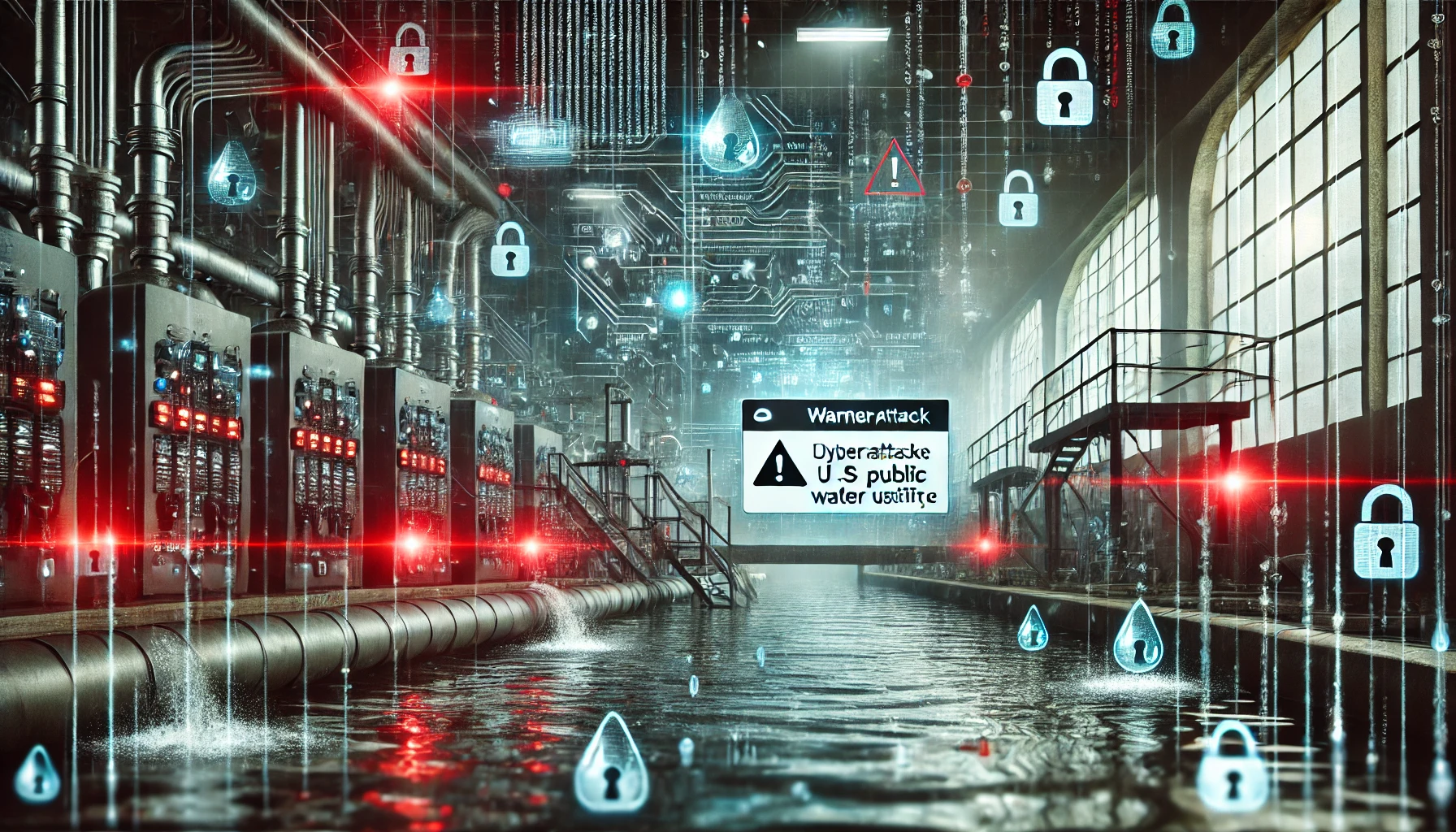
Cyber Attack on Israel Water System A Growing Threat
Cyber attack on Israel water system – it sounds like a plot from a thriller, doesn’t it? But the reality is far more concerning. Israel, facing unique geographical and geopolitical challenges, is increasingly vulnerable to sophisticated cyberattacks targeting its crucial water infrastructure. This isn’t just about disrupting water flow; it’s about potentially crippling the nation’s economy, impacting public health, and even destabilizing the region.
We’ll delve into the various attack vectors, the potential actors, and what steps are being taken – and need to be taken – to protect this vital resource.
From denial-of-service attacks overwhelming water distribution networks to data breaches compromising water quality monitoring, the potential consequences are severe. We’ll explore real-world examples, examine the vulnerabilities of different system components (like SCADA systems), and discuss the crucial role of international cooperation in mitigating these threats. Think of it as a deep dive into the hidden digital battleground protecting Israel’s water supply.
Types of Cyber Attacks Targeting Water Systems
Israel’s water infrastructure, a critical national asset, faces a growing threat from cyberattacks. These attacks can range from simple denial-of-service attempts to sophisticated intrusions targeting sensitive data and control systems, potentially disrupting water supply, compromising water quality, and even causing significant economic and social damage. Understanding the types of attacks and their potential impact is crucial for effective cybersecurity strategies.
Common Attack Vectors Against Water Infrastructure
Several attack vectors are commonly exploited to target water infrastructure. These include phishing emails targeting employees with access to control systems, malware infections spreading through compromised devices connected to the network, and exploitation of vulnerabilities in Supervisory Control and Data Acquisition (SCADA) systems. In the context of Israel, attacks could leverage known vulnerabilities in specific equipment used within the country’s water systems or target contractors with less stringent security protocols.
Furthermore, social engineering attacks, exploiting human error, remain a significant threat. For example, an attacker might impersonate a system administrator to gain access to critical systems.
Impact of Denial-of-Service Attacks on Israeli Water Distribution
Denial-of-service (DoS) attacks flood water management systems with traffic, rendering them unavailable. In Israel, a successful DoS attack against a critical water treatment plant or pumping station could lead to disruptions in water supply to entire communities. The impact could be particularly severe during periods of high demand or extreme weather events, potentially leading to water shortages, economic losses due to business interruptions, and even public health concerns.
The severity would depend on the duration and scale of the attack, as well as the system’s redundancy and resilience measures. A well-coordinated distributed denial-of-service (DDoS) attack could overwhelm even robust systems.
Methods Used in Data Breaches Targeting Water Quality Monitoring Systems
Data breaches targeting water quality monitoring systems in Israel could involve various methods, including SQL injection attacks, exploiting vulnerabilities in web applications used to access monitoring data, or the use of sophisticated malware to exfiltrate data from connected devices. The consequences of such breaches could include the release of sensitive information about water quality parameters, potentially leading to public health concerns if contaminated water goes undetected.
Moreover, compromised monitoring systems could be used to manipulate data, creating a false sense of security while potentially exposing the public to health risks. Such attacks could also cause significant reputational damage and legal repercussions for the affected water authorities.
Vulnerabilities of Different Water System Components
Different components of a water system exhibit varying degrees of vulnerability to cyber threats. SCADA systems, which control the physical infrastructure, are particularly vulnerable due to their often outdated software and limited security features. Physical infrastructure, such as pumping stations and reservoirs, while seemingly less susceptible to direct cyberattacks, can be compromised through manipulation of connected control systems.
Network infrastructure, including routers, switches, and firewalls, forms another critical vulnerability point. A breach in any of these components can have cascading effects on the entire system. Older, legacy systems are particularly vulnerable as they often lack the necessary security patches and updates.
Comparison of Attack Types, Targets, and Consequences
| Attack Type | Target | Potential Consequences |
|---|---|---|
| DoS/DDoS | SCADA systems, network infrastructure | Disruption of water supply, service outages |
| Data Breach | Water quality monitoring systems, databases | Exposure of sensitive data, public health risks, reputational damage |
| Malware Infection | SCADA systems, control computers | System compromise, data manipulation, physical damage |
| Phishing | Employees | Credential theft, unauthorized access to systems |
Specific Threats to Israeli Water Infrastructure: Cyber Attack On Israel Water System
Israel’s water infrastructure faces a unique set of cyber threats, amplified by its geopolitical context and the country’s water scarcity. The vulnerability of this critical infrastructure makes it a prime target for various actors, with potentially devastating consequences. Understanding these threats is crucial for developing effective mitigation strategies.
Geopolitical Context and Motivations for Cyber Attacks
Israel’s ongoing conflicts and geopolitical tensions create a volatile environment where cyberattacks against its water resources can be used as a tool of asymmetric warfare. State-sponsored actors or non-state groups might target water infrastructure to disrupt daily life, damage the economy, or inflict harm on the civilian population. The potential for large-scale damage and the symbolic value of targeting a resource vital for survival makes Israeli water systems a particularly attractive target.
Motivations could range from pure disruption to inflicting economic damage or even influencing political outcomes. The potential for escalation is significant, highlighting the gravity of the threat.
Unique Vulnerabilities of Israel’s Water Infrastructure
Israel’s arid climate and limited natural water resources mean that its water infrastructure is heavily reliant on sophisticated technologies, such as desalination plants and extensive pipeline networks. This technological dependence, while enabling water security, also introduces significant vulnerabilities. The interconnected nature of these systems creates a cascading failure risk, where a compromise in one area can trigger widespread disruption.
Furthermore, the reliance on remote monitoring and control systems increases the attack surface, making the infrastructure susceptible to various cyber threats, from malware infections to sophisticated intrusions. The geographical concentration of critical infrastructure further exacerbates this vulnerability.
Potential State-Sponsored Actors and Their Objectives
Several state-sponsored actors, particularly those with adversarial relationships with Israel, could be motivated to launch cyberattacks against its water systems. These actors might seek to achieve various objectives, including disrupting water supply to major cities, damaging desalination plants, or compromising water quality. The specific objectives would depend on the attacker’s capabilities and geopolitical goals. A successful attack could have significant economic and social consequences, potentially leading to widespread panic and instability.
The potential for escalation is high, requiring constant vigilance and robust cybersecurity measures.
Scenario: Cyber Attack on a Desalination Plant
Imagine a sophisticated multi-stage attack targeting a major desalination plant in Israel. The attack begins with a phishing campaign targeting plant employees, leading to the installation of malware on a critical system. This malware then provides the attackers with remote access, allowing them to monitor the plant’s operations and identify vulnerabilities. The attackers then use this access to manipulate the plant’s control systems, subtly altering parameters to reduce efficiency or even cause equipment malfunction.
The attack culminates in a denial-of-service attack that temporarily shuts down the plant, disrupting the water supply to a significant portion of the population. The impact would include water shortages, economic disruption, and potential public health concerns. The recovery process would be complex and time-consuming, requiring extensive forensic analysis and system repairs.
Real-World Examples and Relevance to Israel
Several real-world cyberattacks on water infrastructure globally highlight the potential threats facing Israel. The 2021 attack on a water treatment plant in Oldsmar, Florida, where an attacker remotely attempted to increase the concentration of sodium hydroxide, demonstrated the potential for malicious actors to directly compromise water quality. Similar incidents in other countries, including those targeting dams and pipelines, underscore the vulnerabilities inherent in these systems.
These examples highlight the need for Israel to invest heavily in robust cybersecurity measures, including advanced threat detection systems, employee training, and regular security audits. The interconnected nature of global water infrastructure means that lessons learned from attacks elsewhere are directly applicable to Israel’s context, requiring a proactive and comprehensive approach to cybersecurity.
Security Measures and Mitigation Strategies

Protecting Israel’s water infrastructure from cyberattacks requires a multi-layered, comprehensive approach that addresses vulnerabilities at every stage, from source to consumer. This necessitates a robust cybersecurity framework incorporating technological solutions, stringent operational procedures, and a highly trained workforce. Failing to do so leaves the nation vulnerable to disruptions with potentially severe consequences, including water shortages, public health crises, and economic instability.
A Comprehensive Cybersecurity Framework for Israeli Water Systems
A robust cybersecurity framework for Israeli water systems should be built upon five pillars: asset management, risk assessment, security controls, incident response, and continuous improvement. Asset management involves identifying and cataloging all critical infrastructure components and their associated vulnerabilities. Risk assessment evaluates the likelihood and impact of potential cyber threats. Security controls implement technical and procedural safeguards to mitigate identified risks.
Incident response Artikels procedures for detecting, containing, and recovering from cyberattacks. Finally, continuous improvement involves regularly reviewing and updating the framework based on emerging threats and lessons learned. This cyclical approach ensures the framework remains effective against evolving cyber threats. For example, regular penetration testing and vulnerability assessments should be conducted to identify weaknesses before attackers can exploit them.
The recent cyber attack on Israel’s water system highlighted the critical need for robust security measures, especially in critical infrastructure. Understanding how to effectively manage cloud security is paramount, and that’s where solutions like bitglass and the rise of cloud security posture management become incredibly relevant. This kind of advanced security posture management is essential to prevent similar attacks and protect our vital resources from digital threats.
Best Practices for Securing SCADA Systems and Industrial Control Networks
Securing SCADA systems and industrial control networks (ICNs) requires a layered approach combining physical, network, and application-level security measures. This includes implementing strong authentication and authorization controls, regularly patching software and firmware, employing intrusion detection and prevention systems, and segmenting networks to limit the impact of a breach. Regular security audits and vulnerability assessments are crucial. Furthermore, the use of robust encryption protocols for data in transit and at rest is paramount.
A robust system of access control, including multi-factor authentication and least privilege principles, minimizes the risk of unauthorized access. Physical security measures, such as access control to critical infrastructure sites, should also be considered. Failure to implement these measures can leave the systems vulnerable to exploitation. For instance, the Stuxnet virus demonstrated the devastating consequences of inadequately secured SCADA systems.
Implementation of Advanced Threat Detection Systems
Advanced threat detection systems utilize sophisticated algorithms and machine learning techniques to identify and respond to cyberattacks in real-time. These systems analyze network traffic, system logs, and other data sources to detect anomalies and suspicious activities that might indicate a cyberattack. This includes the use of security information and event management (SIEM) systems, which aggregate and analyze security data from various sources to provide a comprehensive view of the security posture of the water infrastructure.
The implementation of intrusion detection systems (IDS) and intrusion prevention systems (IPS) are also crucial for monitoring network traffic and blocking malicious activity. Furthermore, the use of threat intelligence feeds can provide valuable insights into emerging threats and help organizations proactively defend against attacks. These systems should be integrated into a larger security operations center (SOC) for comprehensive monitoring and response capabilities.
Cybersecurity Training and Awareness Programs for Water System Personnel
Effective cybersecurity training and awareness programs are essential for building a culture of security within Israeli water organizations. These programs should educate personnel on the importance of cybersecurity, common threats, and best practices for preventing and responding to attacks. Training should cover topics such as phishing awareness, password security, and safe internet practices. Regular security awareness campaigns can help reinforce these messages and keep personnel updated on the latest threats.
The training should also include practical exercises and simulations to help personnel develop the skills needed to identify and respond to attacks. Furthermore, regular updates on the latest threats and vulnerabilities should be provided. A lack of awareness and training among personnel can lead to human error, which is a major cause of security breaches.
Comparison of Cybersecurity Technologies for Israeli Water Infrastructure, Cyber attack on israel water system
Several cybersecurity technologies are suitable for protecting Israeli water infrastructure, each with its own strengths and weaknesses. Network segmentation isolates critical systems from the broader network, limiting the impact of a breach. Firewalls control network traffic, blocking unauthorized access. Intrusion detection and prevention systems monitor network traffic for malicious activity. Data loss prevention (DLP) systems prevent sensitive data from leaving the network.
Endpoint detection and response (EDR) systems monitor endpoints for malicious activity. The choice of technologies depends on the specific needs and resources of each water organization. A layered approach, combining multiple technologies, is generally recommended for comprehensive protection. For example, a small water utility might prioritize cost-effective solutions like strong firewalls and employee training, while a larger utility might invest in more advanced technologies like SIEM and EDR systems.
International Cooperation and Response

International collaboration is paramount in safeguarding global water infrastructure from cyberattacks. The interconnected nature of water systems and the transnational reach of cybercriminals necessitate a unified, proactive approach. Sharing information, coordinating responses, and developing common standards are crucial for effectively mitigating risks and building resilience.The globalized nature of cyber threats transcends national borders, making international cooperation essential. A successful attack on one nation’s water system could have cascading effects on others, highlighting the need for shared responsibility and mutual support.
Effective responses require coordinated efforts to identify threats, share intelligence, and implement countermeasures.
International Initiatives for Water Cybersecurity
Several international initiatives are actively working to improve cybersecurity in the water sector. These initiatives focus on sharing best practices, developing common standards, and fostering collaboration between nations and organizations. For instance, the International Organization for Standardization (ISO) develops international standards for information security management, some of which are directly applicable to critical infrastructure like water systems. These standards provide a framework for organizations to implement robust cybersecurity measures, ensuring consistency and interoperability.
Furthermore, various governmental and non-governmental organizations frequently host workshops and conferences dedicated to sharing knowledge and experiences related to water cybersecurity. These events serve as platforms for exchanging threat intelligence, discussing emerging vulnerabilities, and coordinating responses to cyber incidents. The sharing of anonymized attack data allows for the collective identification of vulnerabilities and the development of preventative measures.
The Role of Information Sharing and Threat Intelligence
Information sharing and threat intelligence are cornerstones of effective cybersecurity for water systems. Prompt dissemination of information about emerging threats, vulnerabilities, and attack techniques allows organizations to proactively strengthen their defenses. Threat intelligence platforms, often collaboratively managed, enable the sharing of real-time information, enabling rapid responses to developing threats. This proactive approach helps prevent attacks and minimizes the impact of successful breaches.
For example, sharing information about a new malware variant targeting SCADA systems would allow water utilities worldwide to update their security protocols and protect their infrastructure.
International Organizations Involved in Water Security
The effective response to a cyberattack on a nation’s water system requires a coordinated effort involving numerous international organizations and agencies.
- United Nations (UN): The UN plays a crucial role in promoting international cooperation on water security, including cybersecurity aspects. Various UN agencies, such as the UN Environment Programme (UNEP) and the World Health Organization (WHO), contribute to this effort by focusing on water resource management and public health implications of water infrastructure disruptions.
- International Organization for Standardization (ISO): ISO develops and publishes international standards, including those related to information security management systems (ISMS) that are directly relevant to water infrastructure security.
- International Telecommunication Union (ITU): The ITU focuses on global cybersecurity standards and best practices, including aspects related to critical infrastructure protection.
- Organization for Economic Co-operation and Development (OECD): The OECD provides guidance and recommendations on cybersecurity policies and practices, often incorporating the water sector within its broader critical infrastructure protection initiatives.
- European Union Agency for Cybersecurity (ENISA): ENISA contributes to the EU’s cybersecurity strategy by providing expertise and support to member states, including in the water sector.
Coordinating a National Response to a Major Cyber Attack
A national response to a major cyberattack on Israel’s water systems would involve a multi-agency coordination effort, led by the relevant government ministries (e.g., Ministry of National Infrastructure, Energy and Water, Ministry of Defense, National Cyber Directorate). Procedures would likely include:* Initial assessment and containment: Rapid identification of the attack’s scope and impact, followed by immediate steps to contain the breach and prevent further damage.
Emergency response
Activation of emergency response plans, including communication protocols and public information dissemination.
Forensic investigation
Thorough investigation to determine the source, methods, and extent of the attack, as well as to identify potential vulnerabilities.
Recovery and restoration
Implementing measures to restore water services and critical infrastructure to full functionality.
Long-term remediation
Strengthening cybersecurity defenses, including infrastructure upgrades, staff training, and improved threat intelligence gathering.
International cooperation
Seeking assistance and information sharing from international partners and organizations.
Impact and Recovery
A successful cyberattack on Israel’s water infrastructure would have devastating consequences, rippling through the economic, social, and political fabric of the nation. The impact wouldn’t be limited to a simple disruption of service; it could trigger a cascade of failures with long-term ramifications.The potential consequences are multifaceted and severe. Disruption of water supply would immediately affect public health, leading to potential outbreaks of waterborne diseases.
Hospitals, essential services, and the agricultural sector would be severely impacted, leading to economic losses and food shortages. The resulting social unrest and potential political instability could further destabilize the region. The loss of public trust in the government’s ability to protect essential infrastructure would be significant. Furthermore, the economic impact would extend beyond immediate disruptions, affecting tourism, trade, and foreign investment.
The cost of recovery, including infrastructure repair, system upgrades, and legal ramifications, would be substantial.
Economic Ramifications
The economic consequences of a successful cyberattack on Israel’s water systems would be substantial and far-reaching. Agricultural losses alone could reach billions of shekels, considering Israel’s reliance on efficient irrigation systems. Businesses would face production halts and supply chain disruptions. The tourism sector, a significant contributor to the Israeli economy, would suffer as tourists avoid areas affected by water shortages.
The overall GDP would experience a noticeable decline, and the long-term impact on investor confidence could further hinder economic growth. We can draw parallels to the economic disruption caused by natural disasters, where the recovery process often takes years and requires significant financial investment. For example, the 2010 Haiti earthquake demonstrated the crippling effect on a nation’s economy following a major disaster, impacting various sectors for years after the initial event.
Social Ramifications
A cyberattack targeting water supplies would have profound social consequences. Water scarcity would lead to increased competition for resources, potentially escalating social tensions and conflicts within communities. Public health would be severely compromised, with outbreaks of waterborne diseases placing a strain on the healthcare system. The lack of access to clean water would disproportionately affect vulnerable populations, such as the elderly and those living in poverty.
This could further exacerbate existing social inequalities and lead to widespread discontent and unrest. Similar scenarios have been observed in other regions facing water crises, where the lack of access to clean water has fueled social tensions and conflict.
Political Ramifications
The political fallout from a cyberattack on Israeli water infrastructure would be significant. The government would face intense scrutiny over its failure to adequately protect critical infrastructure. Public trust in the government’s ability to ensure national security would likely erode. International pressure to improve cybersecurity measures would intensify. Furthermore, the attack could trigger geopolitical tensions, with accusations and counter-accusations flying between states.
The incident could be exploited by adversaries to further destabilize the region. A lack of transparency and a slow response from the government would only amplify these political ramifications.
Recovery Steps
Recovering from a major cyberattack on a water system requires a multi-phased approach. The initial phase focuses on containing the attack, isolating affected systems, and restoring essential services. This involves identifying the source of the attack, removing malware, and restoring data backups. The second phase involves repairing damaged infrastructure and upgrading security systems to prevent future attacks.
This includes implementing advanced cybersecurity measures, conducting thorough vulnerability assessments, and investing in employee training. The final phase focuses on long-term recovery, which includes improving resilience, strengthening partnerships, and establishing robust emergency response plans. This would require substantial investment in both technology and human resources.
Strategies for Maintaining Water Supply
Maintaining water supply during and after a cyberattack requires a combination of strategies. This includes establishing redundant systems and backup power sources, implementing advanced monitoring and control systems, and developing contingency plans for different scenarios. These plans should Artikel procedures for managing water distribution in the event of a disruption. Diversifying water sources and improving water storage capacity are also crucial steps.
Regular cybersecurity drills and simulations can help prepare personnel for responding to cyber threats. Investing in advanced technologies such as SCADA system security enhancements and AI-driven threat detection systems can further enhance resilience.
Infographic Description
The infographic would visually depict the cascading effects of a cyberattack on Israel’s water system. A central image, perhaps a map of Israel with highlighted water infrastructure, would show the initial point of attack. Arrows would radiate outwards, illustrating the impact on various sectors. One section would show the immediate impact: disrupted water service leading to hospital closures, agricultural losses, and public health crises.
Another section would depict the economic impact: decreased GDP, loss of tourism revenue, and business closures. A third section would portray the social impact: increased social unrest, water scarcity conflicts, and heightened public anxiety. Finally, a fourth section would depict the political repercussions: strained international relations, loss of public trust in the government, and increased security spending.
The infographic would use a color scheme to emphasize the severity of the impacts, with darker shades representing more significant consequences. Numbers and statistics would be strategically placed to quantify the losses and highlight the overall magnitude of the crisis. A final section could depict the recovery process, showcasing the steps needed to restore water services and strengthen cybersecurity measures.
The recent cyber attack on Israel’s water system highlights the critical need for robust, secure infrastructure. Developing resilient systems requires efficient development processes, and that’s where learning about domino app dev the low code and pro code future becomes incredibly relevant. These advancements in application development could significantly improve the speed and security of building critical infrastructure defenses against future attacks like the one targeting Israel’s water supply.
The overall design would be clean, informative, and visually compelling, conveying the urgency and complexity of the situation.
Final Review

The threat of a cyber attack on Israel’s water system is a stark reminder of our interconnected world and the vulnerabilities of even the most essential infrastructure. While the challenges are significant, the solutions involve a multifaceted approach: robust cybersecurity frameworks, international collaboration, advanced threat detection, and a commitment to continuous improvement. Ignoring this threat is not an option; the future of Israel’s water security depends on proactive and innovative strategies.
The stakes are high, and the fight to secure this vital resource is far from over. Let’s hope for a future where digital safeguards are as strong as the physical ones.
FAQ Guide
What specific types of malware are most likely used in attacks on water systems?
Malware targeting industrial control systems (ICS) is a major concern. This includes things like custom-built malware designed to exploit vulnerabilities in specific SCADA systems and other industrial control software.
How can individuals help protect Israel’s water infrastructure from cyberattacks?
While most protective measures are at the infrastructure level, individuals can contribute by promoting cybersecurity awareness, supporting initiatives that improve water infrastructure security, and being vigilant about reporting suspicious online activity.
What role does insurance play in mitigating the financial impact of a successful cyberattack on a water system?
Cybersecurity insurance can help cover the financial losses associated with a cyberattack, including costs related to recovery, legal fees, and business interruption. However, obtaining adequate coverage requires careful assessment of risks and tailored policies.





